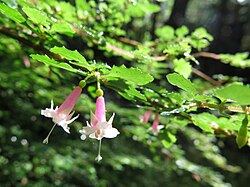Biology:Fuchsia thymifolia
| Fuchsia thymifolia | |
|---|---|

| |
| Scientific classification | |
| Kingdom: | Plantae |
| Clade: | Tracheophytes |
| Clade: | Angiosperms |
| Clade: | Eudicots |
| Clade: | Rosids |
| Order: | Myrtales |
| Family: | Onagraceae |
| Genus: | Fuchsia |
| Species: | F. thymifolia
|
| Binomial name | |
| Fuchsia thymifolia Kunth, 1823
| |
| Synonyms | |
| |
Fuchsia thymifolia is a species of Fuchsia found in Mexico to North Guatemala.[1]
Description
It is a shrub that reaches a size of 1 to 1.5 m in height. The leaves are ovate, 1-5 cm long with an entire edge. The flowers are pinkish white and the fruits are a purple grape-shaped berry.
Chromosome number is 2n = 22.
Distribution
Plants are found in Sinaloa and Durango states of Mexico south towards Chiapas and into northern Guatemala. It inhabits a temperate climate in grassland and forest with oak, pine and Abies mixed pine-oak forests at elevations of 1800 to 3900 meters. [2][3]
Subspecies
There are two recognized subspecies:[1][2]
| Image | Name | Description | Distribution |
|---|---|---|---|
 |
Fuchsia thymifolia subsp. minimiflora | Plant grows 1-3 meters tall. Leaves are elliptic and narrowly ovate with a 8–24 mm long petiole. Flower tube is 2.6-4 mm long | Found in Mexico (Chiapas) and Guatemala (Antigua Guatemala) in forests of Pinus, Quercus, and Arbutus at elevations of 2100 to 2500 meters. |
 |
Fuchsia thymifolia subsp. thymiflora | Plant grows 0.5-2.2 meters tall. Leaves are elliptic and ovate with a 4–17 mm long petiole. Flower tube is 3.5-6.5 mm long | Found in Mexico (Sinaloa, Durango, Jalisco, Vera Cruz, Hidalgo and Oaxaca) in Pinus, Quercus, and Abies forest at elevations of 2000 to 3200 meters. |
Medicinal Use
In Mexico its medicinal use includes the treatment of thrush, sores in the mouth (thrush) and scurvy, and in the State of Hidalgo it is used for diarrhea. As a remedy, it is advisable to grind or chew the fruit and the leaf to apply it locally, or take the decoction of the aerial part. Another use that is given is in cases of cough.[3]
References
- ↑ 1.0 1.1 "Fuchsia thymifolia Kunth". http://powo.science.kew.org/taxon/urn:lsid:ipni.org:names:612665-1.
- ↑ 2.0 2.1 "Onagraceae". https://naturalhistory2.si.edu/botany/onagraceae/speciesdescr.cfm?myID=4286.
- ↑ 3.0 3.1 "::: BIBLIOTECA :::". 2013-06-10. http://www.medicinatradicionalmexicana.unam.mx/monografia.php?l=3&t=Aretillo_de_la_virgen&id=7119.
External links
Wikidata ☰ Q15333213 entry
 |

